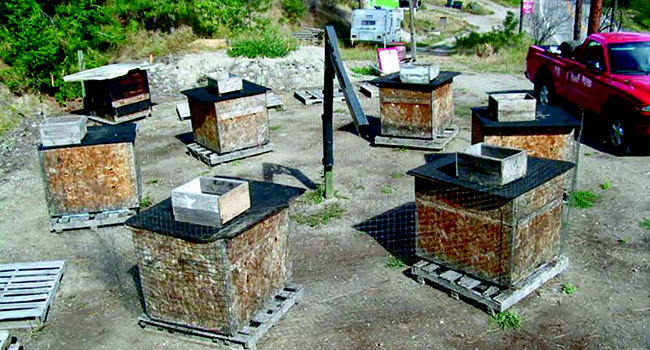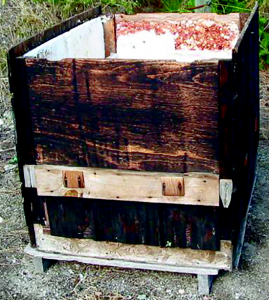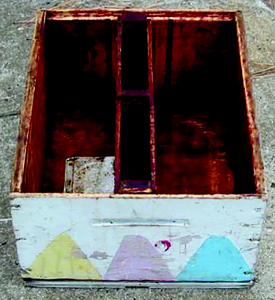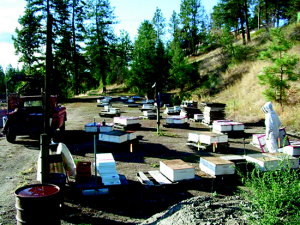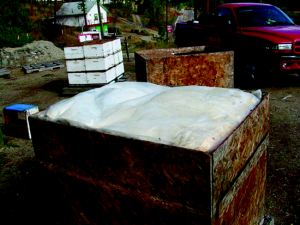By: Bill Ruzicka
Poverty is the mother of all inventions, and men learn by experience – How to Winter 72 eight-frame colonies in one circle of six towers each housing 12 colonies in insulated boxes. Winter packing and ventilation – truths, myths, and laws of physics.
In the August issue you read how we prepare our hives for Winter. Today we go through long line of many changes that took me to the successful wintering I’m doing today. But remember without the August prep and FORMIC ACID MITEGONE mite treatment, no packing can do miracles. It is the whole process which saves your bees.
In 1980 the 100 hive outfit I bought had 22 hives alive. My mentor wintered his hives in groups of four wrapped and covered with paper backed 3½” fiberglass insulation. On top was ¼” tar coated plywood bent over four feeder pails under insulation and tied with ropes in a dome. In the snow it look like heaps of hay forgotten in the field.
As a young buck who knows better, I did the same thing but put all 22 hives in two rows back to back, side to side. I put the feeders on top. Not having enough money for plywood, I found an old tarp and covered the whole thing and tie it down using old tires like the guys use on hay.
FIRST EXPERIENCE: Learned was about drifting. At the end of each big pack I had four extremely strong colonies, then some weaker and some extremely week in middle.
I also learned that the insulation would be unusable next year. You can boost weak hives from strong ones, and that carrying single hives in pollination is a very hard work which I will not do again. Therefore I had to come up with some other system. Fortunately the place I worked as engineer WESTERN STAR TRUCK PLANT had a lot of scrap pallets, had odd sizes of plywood and short 2x4s and much more. My grad paper was written on the use of Aircraft scrap material in other sectors of national industry, Simply Sanford and Son if you remember that show.
I also bought 100 packages and decided to go commercial. I brought in a D8 and carved up a big flat bee yard from my property and started to utilize the scrap from Western Star. All pieces were smaller and odd to use in construction, they were low quality or eastern hard wood, but well suited for beekeeping as you see on pictures: Transmission pallets were best for hive supports, they were a foot high to accommodate shafts and being of eastern hardwood many are in use still now.
I promised myself I was never again going to carry hives one by one into orchards. I converted my old 61 GM into ¾ ton rear axle, installed a hydraulic system with electric command and set up the “four pack” system.
The plywood from plant and other wood scrap made the bottom boards and migratory covers for two and four hives packs.
EXPERIENCE: four packs weigh 800 lbs and cannot be stolen and cannot be moved without a crane.
Doubles can be lifted by two men and used in pairs as four packs, but two men can carry double and only one got stolen in those years. The plywood from plant was also great to make the winter boxes. As you can see in the next picture they were reworked many times.
The first version was for the double high with the feeder pail on top:
EXPERIENCE Temperature and air pressure changes pushed and spilled feed out, drowning weak colonies.
I also started to experiment with wintering nucs but decided to do all with std. deep frames. On lower picture you see how I made three color three frames units in one box with ¼” slots for divider boards and dry top feeders. Feed main hives early and put the nucs on top of main hives but that required to raise wintering boxes to accommodate insulation blanket on top and provide entrances for six nucs in row in front.
EXPERIENCE: Not too great. Try something else.
As I was dissatisfied with feeder pails and needed nucs. So I created a wooden inner feeder replacing two tandard frames. When put on standard bottom board with strip of carpet in middle I had two to four frame mating nucs. Please note that the feeder has two compartments joined by ½” gap under center divider and that the top half is open to the right and the closer one to the left. The higher sides form the letter “S” so when carpet is put on the top the two nucs are sealed separately. We would have 550 of these, providing 1100 mating units to ensure our new generation as all old queens were sold with SWARMS.
If one did not mate, we just moved the feeder to the side and had eight frame colonies if both mated we caught and sold one and then made an eight framer.
The feeder can be moved to any position creating from three frame mating nuc to six frame wintering unit and two frame space behind the feeder through which I could feed the lower hive through 1½” hole plugged by screen.
Please note the screened entrance 2” x 3/8” high.
We wintered our 560 hives in two deep and six framer on top, in our winter boxes for many years. We fed in late February early March both colonies moving feeder back and adding two frames to the six frame unit to have 10 frame pollination unit in early April.
THIS Lasted till 1996 when the disaster struck.
A beekeeper from the Peace River region had a Kelowna beekeeper Winter and use for pollination 500 of his hives and he left his partner infected with AFB.
The guy in Kelowna obviously was not too careful and by mid Summer his 100 hives were fully infected and committed to burn by local inspector. He wanted to save them so he went to get a burning permit which he knew will be denied. Our provincial “wizard” comes with a solution to bury the infected comb in the garbage dump. They dug a hole for the first load and buried it. There was no hole for the second load and the 3rd load so the guy just dumped it into the garbage. Unfortunately, I had a yard with 40 honey producing and 40 six-framer just on east side of dump ¼ mile from dump site. My main breeding yard with 40 honey producing colonies and 100 six-framers ½ mile to the west and Gorge yard and home yard a mile to west and north. At 4pm I received a call from the dump foreman” Bill please come all my people are being killed by bees”. When I arrived there was the biggest black cloud of bees over the dumped equipment robbing it. Having just a veil with me I got on the D-8 smashed all bee equipment and bees and buried it under other garbage. I went home mixed barrel of light feed with oxytet and started to drench hives in all four yards each week and checking them and burned few I suspected.
OXYTET WILL NOT CURE AFB BUT IT WILL PREVENT INFECTING four to seven DAY OLD LARVA and prevent forming of scales as long as it is present but once you stop and if there are scales the spread of AFB will be fast.
We decided to feed OXITED until late Fall but withdrew it after and did not feed any in February feed.
The February – March feed was mainly done to feed the drugs which I cannot do, to be able to check all hives find any scales and dispose of infected colonies to have whole outfit clean.
Therefore, I decided not to feed. I increased the wintering weight of two high and give to top units eight frames.
In late March I had our provincial “wizard” to summon all BC inspectors and we went through all colonies comb by comb: We were clean.
EXPERIENCE: All bad things sometimes produce a good result:
I NEVER FED IN FEBRUARY – MARCH AGAIN.
I just feed to my wintering weight and Winter on top eight framers. This brings us to the next section:
Winter packing and ventilation: Truths, myths, and laws of physics.
When I was taking apart the Winter packs in Spring, I noticed that the top eight-framers were many times much stronger than the double colonies below. They did not have any moisture problems, regardless that the screened holes which should have provided warm air from lower colonies were plugged and sealed.
The only difference was the lower colonies had Winter Entrances and wood top covers acting also as nucs bottoms the nucs did have carpets on top and 3½” fiberglass insulation pillow on top for all four units. They were all in a Winter pack covered by asphalt painted plywood.
It was the time to put my thinking cap on. Remember the meteorology lessons of my flying days, and the adiabatic functions of gases of my university years.
ASK YOURSELF QUESTIONS:
WHY WE HAVE WINTER ENTRANCES? The only reason I could accept was that in lands of Winter blizzards the lower entrance can get plugged, and bees can use upper entrance to go for cleansing flights.
In years of early feeding I also practiced cleaning of lower entrances. There was some debris but the entrances never got plugged by snow. Therefore that reason did not apply.
WILL YOU IN YOUR HOUSE OPEN THE FRONT DOOR AND UPPER WINDOW AND LEAVE IT OPEN ALL WINTER? I would not! It would cost me a fortune in heating. Why we do it to the bees?
The Winter entrance and Winter cover with its space above tops of frames creates a stove and chimney out of the hive. The colony and cluster is the heater, the fuel is honey, and the heated air is going out the chimney “the Winter entrance”.
THE MYTH…SOMEONE TOLD US THAT THIS TAKES OUT THE MOISTURE OUT OF HIVES.
Truth: In my early years needing money I offered the removal of feral colonies in trees and walls. I helped to cut down two. All had a lot of bees and honey but only one entrance, usually at the bottom. On one occasion, in the wall of old cold storage house, where the double wall was two feet apart and filled with saw dust that had settled down, there were two knot holes but the upper one was plugged with propolis.
I also saw colonies hanging under rock overhangs in Arizona. Do you know how cold it is there? But combs are attached directly to the rock, there is no space above frames so each space between combs has its own heat control. Fresh air enters at bottom and gets heated to brood temperature of 34-35°C. I do not know if the bees know the laws of physics but they apply.
As many times as they heat the air up, that many times they lower the relative humidity of air.
Bees get in nice dry fresh air, and a lot of times they have to bring in water to maintain 55% humidity required by brood, otherwise larva will dry and die.
I confirmed this in designing Mitegone. I measured temperature between the frame and wall of hive adjacent to next hive in April when outside temperatures were as low as below freezing. In the morning humidity at the entrance is 100% and as high as 25°C and 40% humidity in late mid day. The temperature and humidity inside was constant 26-28°C and 55% humidity on strong hives covering most of upper box combs.
At the same time I was conducting Test of “WINTER ENTRANCE FUNCTION.
To be scientifically and statistically correct all 260 lower hives in all yards were divided into two groups A & B.
Group A was wintered with WINTER ENTRANCE with existing wood Inner cover also acting as upper colony bottom board without any screen connection and 1”upper entrance holes in the winter box were open.
Group B was wintered without WINTER ENTRANCE given carpet on top of hive with upper colony on it. The Winter entrance holes in packs were permanently plugged and insulated.
To eliminate location position and yard differences, in each yard one circle of 20 hives had group A on inside circle and the other on outside.
RESULTS: while none of strong hives in neither group had any problem of moisture the hives with Winter entrances consumed 90-95% of their stores while Group B without Winter Entrances had 25-30%
Stores left (Equivalent of two to three Frames) our Winter loses were 5-7% and on weak and dead colonies other problems mildew and rot was occasionally found.
EXPERIENCE: Winter entrances in our area do not provide any help with moisture control and cause large consumption of stores.
Please note that bottom of Okanagan Valley is prone to valley cloud being miserable ugly foggy wet below cloud and sunny cold above. This saves our orchards from freezing.
I have not used Winter entrances since then.
WHERE IS THE MOISTURE PROBLEM COMING FROM? Answer is the CONDENSATION.
In feral colonies and my hives the air enters by bottom entrance as it is heated it bsorbs moisture, becomes heavy and moves to the bottom of the box. Just last week I talked to people on Vancouver Island who were asking: How their insulated hives without Winter entrances but fully open screened bottoms will effect the MiteGone acid treatment? It will lower efficacy but the use of monitoring trays will increase it. I asked if they have the moisture problem they say no and I agree. In both hives walls and tops are kept warm so condensation cannot occur and wet heavy air flows out the bottom.
What happens in non insulated WINTER ENTRANCE HIVE? The air enters in bottom, gets heated and absorbs moisture. When this air gets into contact with cold outside walls or the inner or top cover the moisture in air condenses on these surfaces and drips back to the hives causing problems you all know.
How to Winter 72 – eight-frame colonies in one circle of six towers each housing 12 colonies in insulated boxes
On 20th of September at 9 am. All hives are uncovered, the Summer covers loaded to go home. They were all treated and fed to wintering weight and are ready to be packed.
First the front circle is on standard board being cleaned and leveled so the towers are straight and solid.
All other hives are on nuc bottoms housing eight frames colonies and feeder so we can feed the last missing feed to proper wintering weight.
As the hives are brought in the towers are growing up.
The Winter packs are brought in and assembled around them. The narrow fronts are screwed onto sides with four screws and 3½” insulation bath are put on top.
Here you have it finished. A yard with top covers and mounted on bear fence activated by 27000 volts.






